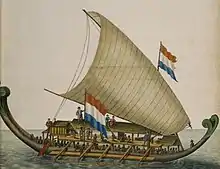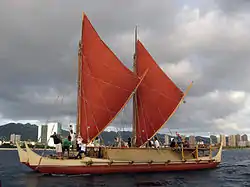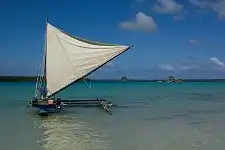Juanga (ship)
A juanga or joanga refers to large-sized kora-kora or karakoa.[1][2] They are used in Southern Philippines and Eastern Indonesia, in Maluku smaller versions existed. They are propelled by oars but are not used for carrying cargo.[3]

Etymology
The word juanga and joanga cognates with "junk", which refers to several type of ships in Asia. Retana and Pastells considered the name derivered from Chinese word chun, which means boat.[4]:299 Paul Pelliot and Waruno Mahdi rejects the Chinese origin for the word "junk".[5][6]:38 The word jong can be found in a number of ancient Javanese inscriptions dating to the 9th century.[7][8]:748 It was first recorded in the Malay and Chinese language by the 15th century, when a Chinese word list identified it as a Malay term for ship,[9]:60 thus practically excludes the Chinese origin of the word.[7]:266
Description

Indonesia
According to a manuscript probably made by António Galvão ca. 1544 the ship was made in this way: The shape in the middle of the ship resembles an egg (he ovedo no meio) and the ends curl upwards. Thus, the ship can sail forward and backward. These vessels were not nailed or caulked. The keel of the ribs, as well as the front and rear height are adjusted and painted with fibers (guamuto, in the local language gomuto) through holes made in certain places. On the inside there is a protruding part in the form of a ring for inserting the strap so that it is not visible from the outside at all. To connect the boards, they use a pen on the other end of the board to make a small hole to insert the pen. Before joining these boards, they were given a pen to keep water from entering: spliced together, the boards were sandwiched so that it looked as if they were standing from one blade only. In the bow is inserted "wood (carved) in the form of a snake with a dragon's head with horns like a deer".[10]
When the ship is finished, ten or twelve well-worked beams are laid across from the hull to the hull. These beams are called ngaju, serve as supports as in galleys, placed carefully until it doesn't wobble anymore. This ngaju protruded from the sides of 1, 2, or 3 braca (1 braca is about 0.3043 meters) according to the size of the ship. Above this ngaju, parallel to the ship, were tied two or three rows of bamboo, called a cangalha. In this place the rowers sit (so on the water), separated from the other rowers who are in the space of the ship. At the very end of this ngaju there are several branches. Called the pagu, as a place to tie other bamboos that are bigger and longer, this bamboo is given the name samsah (semah-semah, the local name for outriggers), to support the ship when it rolls.[11]
In the ngaju part of the ship, a floor of split rattan, a kind of upper level or deck, is made, which is called baileo. If they ever wanted to do evil to the people who sailed on it, namely those who were armed, they could sweep the baileo with their ngaju; and the soldier fell into the water and drowned. In baileo, booths such as the toldo and conves were made, that is, a section on Portuguese ships used to be specifically for officers and dignitaries. The kolano (kings of northern Maluku) occupy it whilst lying or sitting on halls, and beside it was a place for captains, ministers and armed soldiers. They are called "baileo people". Above these booths are covered with mats, called kakoya, from the bow to the stern like a tent in a galley (como temdas de geuale) for shelter from the hot sun and rain. The kolano along with their siblings and the sangaji used a tent made of white kakoya and are called papajangga, which are rectangular. At each corner of this tent flew a flag made of feathers like the tail of a chicken, moreover there were two other flags in front almost as high as sea level, one each on the left and right, made of red cloth "which are not rectangular but resembled a tongue". The king's flag was raised from the mast in the middle of the ship.[12]

While the king and the captains with the minister sailed on the baileo, their young sons stayed below, the others sat in the cangalha rowing. When these sons were promoted, they were ordered to go up to Baileo and did not have to row anymore. This is a great honor for them. If they are not meritorious, they may not use the sword or be given a promotion, which is the same price as being awarded a title. From the cangalha they were put on board, and this too was an honor. Then, if they are meritorious, they were put on baileo again and abandon the oar. The paddle is very well carved, light, and shaped as an iron spearhead, sometimes round. The stalk is one covado (± 20 inches, 50.8 cm), the head is a small cross (huma cruzeta peqeuna) as a handle, while the left hand holds the leaf. The oars are free (not tied). And they are called pamguayo (pengayuh - rowers). The wood is also used as a dinner plate and a place to cut any item (servem de comer neles e d'al qualquer cousa em hum trimcho). The sails are made of burlap or from mats.[3]
According to the same manuscript, in Maluku there are many types of ships, the most important of which is called the juanga, which resembles a royal galley (guales reaes). There are also other ships called lakafuru, kora-kora, kalulus, and small boats. Each of them is driven by oars and is not used for carrying loads, the space is long but not deep, a juanga can carry 200 oars per hull side, plus nearly 100 baileo men (e mais perto de cemhomens de baileu). However, there are also smaller juanga carrying only 150 paddlers per side and 50 people on Balieo, some are even smaller.[3] Usually juanga, lakafuru, and kora-kora carried 1-3 boats, but in case of danger these boats may be discarded onto the sea.[13]
Philippines
At the end of 18th century, Iranun people generally cruised in squadrons of 30 to 40 joanga with a single fleet commander and a nakodah on board each joanga. There were also many warriors of various ethnic groups and, if required slaves.[14] In addition to the rowers and crew, every joanga carried a complement of warriors numbering upward of 100 in the largest vessels. The warrior took no part in sailing the ship, and were there simply to fight and engage the enemy vessel. They were will be attacking with grappling poles, boarding lances, muskets and the kampilan. The commander of the marines had no direct say over the sailing of the raiding ship, but he was a superior officer and made decisions in consultation with the nakodah about whether or not to attack a coastal settlement or engage a passing vessel.[15]
History
Indonesia
Juanga was first recorded in a Portuguese manuscript on the history of Maluku, which was probably written by António Galvão in about 1544 published by H. Jacobs, S.J. It contains description of how the people in (North) Maluku build their ships.[16][17] Juanga is used by Sultan Khairun of Ternate for transporting troops in Ternate-Portuguese conflicts between 1530-1570.[18]
After a rebellion in Tidore ender in 1722, Patani and Maba people who fled to Galela since 1720 were moved to Salawati in the Raja Ampat islands using a total of 30 juanga. On July 4, 1726, 17 juanga and 6 large boats loaded with Papuan and Patani people docked in front of the Oranje fort and landed in a Malay settlement beside the fort. From here the Papuan and Patani people walked to the palace of the Sultan of Ternate to report the various treatments they had experienced from high-ranking officials of the Tidore Sultanate. The VOC (Dutch East India Company) sent officials to talk the defectors. To VOC officials the Papuans and Patani expressed their desire to become subordinates of the Sultanate of Ternate and the company. They also demanded to be treated as refugees and guaranteed their safety.[19] Prince Nuku in 1804 used juanga in his revolt against the Dutch (c. 1780-1810), for mobilizing troops to attack North Halmahera.[20]
See also
References
- Horridge (1982). p. 37 and 70.
- Mallari (1989). p. 424.
- Poesponegoro (1981). p. 114.
- Galang, R.E. (1941). "Types of watercraft in the Philippines". The Philippine Journal of Science. 75: 287–304.
- Pelliot, P. (1933). Les grands voyages maritimes chinois au début du XVe siècle. T'oung Pao, 30(3/5), second series, 237-452. Retrieved from http://www.jstor.org/stable/4527050
- Mahdi, Waruno (2007). Malay Words and Malay Things: Lexical Souvenirs from an Exotic Archipelago in German Publications Before 1700. Otto Harrassowitz Verlag. ISBN 9783447054928.
- Manguin, Pierre-Yves (1993). "Trading Ships of the South China Sea. Shipbuilding Techniques and Their Role in the History of the Development of Asian Trade Networks". Journal of the Economic and Social History of the Orient: 253–280.
- Zoetmulder, P. J. (1982). Old Javanese-English dictionary. The Hague: Martinus Nijhoff. ISBN 9024761786.
- Reid, Anthony (2000). Charting the Shape of Early Modern Southeast Asia. Silkworm Books. ISBN 9747551063.
- Poeponegoro (1981). p. 112-113.
- Poeponegoro (1981). p. 113.
- Poeponegoro (1981). p. 113-114.
- Poesponegoro (1981). p. 115.
- Warren (2002). p. 170.
- Warren (2002). p. 172.
- Poesponegoro (1981). p. 112.
- Hubert Theodorus Thomas Marie Jacobs (ed) (1971). A treatise on the Moluccas (c. 1544) probably the preliminary version of António Galvão's lost História das Molucas. Rome: Jesuit historical institute. p. 156, 157, 162-163.
- Amal (2016). p. 252.
- Amal (2016). p. 149.
- Amal (2016). p. 39.
Further reading
- Amal, M. Adnan (2016). Kepulauan Rempah-rempah. Kepustakaan Populer Gramedia. ISBN 9786024241667.
- Mallari, Francisco (1989). "The Spanish Navy in the Philippines, 1589-1787". Philippine Studies Vol. 37, No. 4. pp. 412-439.
- Marwati Djoened Poesponegoro and Nugroho Notosusanto (1981). Sejarah Nasional Indonesia III. Departemen Pendidikan dan Kebudayaan.
- The Lashed-lug Boat of the Eastern Archipelagoes, the Alcina MS and the Lomblen Whaling Boats. By G. Adrian Horridge. Greenwich, London: National Maritime Museum. Maritime Monographs and Reports No. 54, 1982. Illustrations, Notes, References.
- Warren, James Francis (2002). Iranun and Balangingi: globalization, maritime raiding and the birth of ethnicity. NUS Press. ISBN 9789971692421.



.jpg.webp)